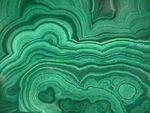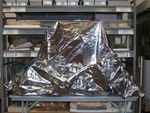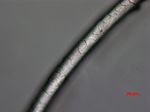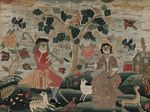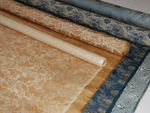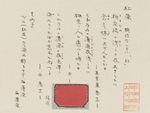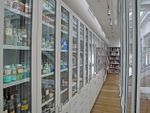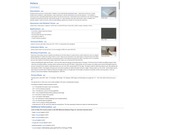Difference between revisions of "Main Page"
| Line 43: | Line 43: | ||
[[File:FS NMMA Shirtag BF 150x150.jpg|link=https://asia.si.edu/|100px|left]] | [[File:FS NMMA Shirtag BF 150x150.jpg|link=https://asia.si.edu/|100px|left]] | ||
| − | [https://asia.si.edu/ The Freer Gallery of Art and Arthur M. Sackler Gallery, the Smithsonian’s National Museum of Asian Art], in cooperation with the Boston Museum of Fine Arts, have created the [[:Category:Asian Textile Database|Asian Textile Database]], an open-access resource to facilitate the international study and appreciation of Asian textiles. This project began in 2005 as a digital inventory of textiles used to mount East Asian scrolls. While working with textile scholars, conservators realized the impact this growing resource of technical data could have on research in the field. Because historic Asian textiles are inherently fragile and scattered in collections across the globe, access is often restricted, making comparative analysis difficult. Research is siloed because there is no repository of data that is generally available and consistently updated. The Asian Textile Database is a Wikimedia database that provides a centralized data source and invites researchers, conservators, and conservation scientists to share information about collections and cooperate in building this international research tool. | + | [https://asia.si.edu/ The Freer Gallery of Art and Arthur M. Sackler Gallery, the Smithsonian’s National Museum of Asian Art], in cooperation with the Boston Museum of Fine Arts, have created the [[:Category:Asian Textile Database|Asian Textile Database]], an open-access resource to facilitate the international study and appreciation of Asian textiles. This project began in 2005 as a digital inventory of textiles used to mount East Asian scrolls. While working with textile scholars, conservators realized the impact this growing resource of technical data could have on research in the field. Because historic Asian textiles are inherently fragile and scattered in collections across the globe, access is often restricted, making comparative analysis difficult. Research is siloed because there is no repository of data that is generally available and consistently updated. The Asian Textile Database is a Wikimedia database that provides a centralized data source and invites researchers, conservators, and conservation scientists to share information about collections and cooperate in building this international research tool. |
| + | |||
| + | Explore the [[:Category:Asian Textile Database|Asian Textile Database]] | ||
</div> | </div> | ||
Revision as of 15:14, 28 July 2020
Conservation & Art Materials Encyclopedia Online
The Conservation and Art Materials Encyclopedia Online (CAMEO) is a database that compiles, defines, and disseminates technical information on the distinct collection of terms, materials, and techniques used in the fields of art conservation and historic preservation. First developed as a materials database in 1997 at the Museum of Fine Arts, Boston it has expanded with the cooperation of multiple institutions to include several reference collections. Learn more about CAMEO.
To use CAMEO, select any of the databases on the left or below, or simply search by entering text into the search box at the top right.
|
Reference Collections
|
|
|
|
|
|
NEWS & UPDATES
XX, 2020
The Freer Gallery of Art and Arthur M. Sackler Gallery, the Smithsonian’s National Museum of Asian Art, in cooperation with the Boston Museum of Fine Arts, have created the Asian Textile Database, an open-access resource to facilitate the international study and appreciation of Asian textiles. This project began in 2005 as a digital inventory of textiles used to mount East Asian scrolls. While working with textile scholars, conservators realized the impact this growing resource of technical data could have on research in the field. Because historic Asian textiles are inherently fragile and scattered in collections across the globe, access is often restricted, making comparative analysis difficult. Research is siloed because there is no repository of data that is generally available and consistently updated. The Asian Textile Database is a Wikimedia database that provides a centralized data source and invites researchers, conservators, and conservation scientists to share information about collections and cooperate in building this international research tool.
Explore the Asian Textile Database
July, 2020
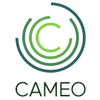
The CAMEO homepage now has a new logo and look!
We would like to thank Scott Na'auao of Welcome Stranger for his generosity in designing the new logo. Thank you!
June, 2020
The Materials Selection and Specification Working Group (MWG) at the American Institute for Conservation (AIC) is leading an effort to provide a resource bank of information that will help develop best practices in selection of materials used in the preservation, transport, and display of cultural heritage. CAMEO has been designated as the platform for the consolidated information on materials with new sets of information added under the headers: Applications, Personal Risks, Collection Risks, Environmental Risks, Working Properties, and Forms/Sizes. The ‘Additional Information’ field will contain links to the Oddy Test results residing in the AIC Wiki. The ‘Environmental Risks’ section will be populated with information developed as part of the recently funded NEH grant for Life Cycle Assessment of materials and treatments used in cultural conservation. CAMEO will also provide links to the Life Cycle Assessment tool that will enable the comparison of carbon footprints for over 3000 materials.
View: Materials Working Group Database
